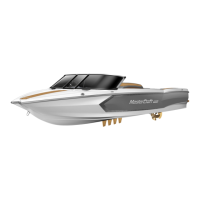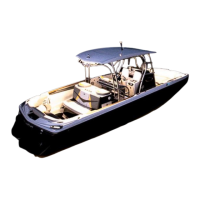Step 5: If leakage is apparent, tighten the hose clamps, being careful not to crimp the hose. If the leakage is
significant or is occuring at a location other than the joints (such as a split in a hose), see your MasterCraft dealer
for parts and service. This is important! Exhaust fumes can cause illness or impairment, including carbon
monoxide poisoning. Equally important to consider, leakage can lead to a build-up of potentially explosive
fumes within the engine compartment. DO NOT IGNORE NOR OVERLOOK THIS INSPECTION! REPAIR
AS NECESSARY!
Check that the battery is fully charged
As you start your boat, check all gauges,but pay particular attention to
the voltmeter.
While starting the engine, check that the voltmeter reads between 12.4 and
14.5. An erratic reading can be a sign of low voltage. The voltmeter is your
best indication of the state of your battery. It is not fool-proof, however. While
the reading will indicate that the battery is producing current, if in a previous
operation you had reason to suspect a problem with your battery, check with
your MasterCraft dealer.
The 2004 models are equipped with a low-voltage battery alarm. In the
event that the stereo has been functioning when the boat is not ON and
running, the voltage drain on the battery can result in difficulties re-starting the
boat. To avoid this situation, when the voltage level reaches a set level of 11.5
volts, the system will shut off the stereo system and sound the alarm for a
period of two minutes to give boaters ample time to adjust.
If you have a dead battery, charge it with a battery charger before attempt-
ing to start the engine. Jump-starting from another boat or battery is danger-
ous. Charging a dead battery with the alternator on your engine will put undue
stress on the alternator, which may cause it to fail.
Check the engine oil level
Because you will get an accurate reading only
after the engine has run long enough to thor-
oughly warm up (to at least 140 degrees F), this
should be one of the last checks you conduct
before boating. Run the engine in the water. If
you are checking the transmission fluid at the
same time, run the engine at least five minutes in
the water (to warm the transmission fluid), and
check the fluid immediately after shutting down
to get an accurate reading for that. As long as
you will be checking the oil fairly quickly (within
two minutes of shutting off), there is no need to
re-start and run the engine again.
BEFORE EACH USE
17-9
When charging, batteries generate small amounts of dangerous hy-
drogen gas. This gas is highly explosive. Keep all sparks, flames and
smoking well away from the area. Failure to follow instructions
when charging a battery can cause an electrical charge or even an
explosion of the battery which could cause serious injury or death.

